SEO
Designing In Wix is Faster

Matt Mullenweg, the creator of WordPress, questioned why a revamp of the WordPress homepage and download page took weeks to almost finish when the same project would take one person only hours to complete using a website builder platform like Wix or Squarespace.
What happened is that a group of WordPress contributors decided to revamp the WordPress home and download pages using the WordPress block editor as a showcase for what could be accomplished with the new editor.
Everyone commenting on the proposal expressed that it was a great idea to use the WordPress block editor.
But a month later, Mullenweg questioned why it took a team of WordPress developers weeks to create just two pages.
He wrote that he had a hard time imagining one person taking longer than a day to finish the project with Software as a Service (SaaS) website builder platforms like Wix or Squarespace.
Mullenweg wrote:
“…it’s such a basic layout, it’s hard to imagine it taking a single person more than a day on Squarespace, Wix, Webflow, or one of the WP page builders.”
The implication of his statement is clear.
WordPress Block Editor
The block editor, also known as the WordPress Gutenberg Editor, was introduced in 2018. Still, it wasn’t until 2021 when a significant feature of full site editing, the template editor, was released as part of WordPress 5.8 and the template editor.
More parts of the complete site editing experience followed over the months.
The goal of the block editor is to modernize WordPress and make it easy for anyone to install and start building a website fast.
The block editor is the future of WordPress, but it’s not quite finished as it continues to be improved upon.
WordPress Home Page Revamp
On July 8th, 2022, a WordPress contributor (and employee of Automattic) announced the kickoff of a redesign of the official WordPress.org homepage and download page, with the proposal of doing it using WordPress’ block editor.
The block editor is part of the WordPress initiative to modernize it and make it easy to design websites without learning code.
The idea was to showcase the WordPress block editor.
The announcement was well received.
One WordPress contributor commented:
“I’m very excited to see this project blossom for WordPress.
…Leveraging the homepage as a place to showcase everything modern, innovative, and empowering, that WordPress can be, would be a wonderful objective.
In other words, with WordPress, you can basically do anything – build anything.
I’d love to see the design showcase the modernization of the site editor and layout capabilities – even going so far as to do things many haven’t seen before.”
Another posted:
“I’m super excited about this project!”
Someone else wrote that it was a great way to showcase the editor and the WordPress community:
“The biggest opportunity I’m seeing, on the Homepage in particular, is a more cohesive WordPress story.
Aside from the power of the software itself and what it can do, there’s the whole community of people that have been coming together regularly to share in a movement.”
All the comments were positive and upbeat.
Then about eight days later, Mullenweg criticized how long it recently took to redesign the WordPress News page and noted that this project should not take as long to complete.
He posted:
“This should take a week or two to launch, not months, and the most interesting part will be the stats and feedback after launch, and any subsequent iterations we make from there, not a long process before.
The /news redesign took a criminally long time.
We have a lot of .org to redesign, and a lot of accumulated cruft for example in the navigation right now — we can’t take too long on any one part.”
One Month Later… Mullenweg Criticizes Pace of Project
A month went by as the team worked together creating the two pages, and on August 1st, they shared an update in a post titled, Developing the redesigned Home and Download Pages.
The post is a cheerful update on all the progress that has been made on the still incomplete redesign.
Eight days later, Mullenweg kicks off the discussion by criticizing the effort, commenting:
“This is not a good use of time, nor does it further the actual goals of a new homepage or download page, and we have better places to spend our development time.”
The developer who is leading the redesign defended the pace of progress, writing:
“That’s less than three weeks from design to launch and I’m very proud of the collaborative work the team has been able to do. The new theme is great. The teams involved have built an outstanding theme in record time. I think people will love it.”
Others also posted support for the progress.
Mullenweg criticized the pace of the redesign:
“33 days since project kickoff doesn’t feel quick to me, but I think it’s worth diving deeper into not trying to turn Figma designs into a theme quickly (again though, that should be hours not weeks)…”
He next expressed his vision that this should be progressing faster:
“You could imagine a world where instead of taking more than a month to launch a single design, which implies a maximum rate of under 12 of these we could do in a year, we made 20-30 designs up front, ideally with very different approaches and copy, and focused our development time on measuring the success metrics of each approach, then iterated from there.”
He then compared the slowness of developing on WordPress to how fast it is on SaaS website builder platforms:
“…On the ‘hours not weeks’ to implement — it’s such a basic layout, it’s hard to imagine it taking a single person more than a day on Squarespace, Wix, Webflow, or one of the WP page builders.”
Lastly, he suggested using the existing code approach:
“So, if we’re just doing a prettier version of the same thing, make those changes in place with the existing code approach quickly and move on to something higher value.
If you are trying to further WP itself, you need a fundamentally different approach.”
Response To Criticism
The response on Twitter ranged from sarcastic digs at WordPress to support for the team working on the redesign.
The owner of WordPress complaining (to his volunteers) that a block theme takes too long and they should just update the custom HTML in their current theme… Welcome to the last five years of block editing @photomatt!https://t.co/mI4zKBnO6T
— Brian Coords (@briancoords) August 11, 2022
33 days from kickoff to launch is quick in any enterprise project.
— John Locke 🐝 (@Lockedown_) August 11, 2022
Wow. Did Matt just nuke block themes in general? That was very concerning.
— Hendrik Luehrsen (@hluehrsen) August 11, 2022
But some supported Mullenweg:
I gotta say I am with @photomatt here. 33 days for a soft relaunch of two landing pages, page builder or not, is … a lot.
I too have used static php/html for load heavy pages. That being said, devs running loose on their own, it happens in every project. No biggie, me thinks.
— Peter Carqueville (@PCarqueville) August 11, 2022
Is WordPress Inferior To SaaS Website Builders?
Mullenweg’s comment likely reiterated the WordPress vision that development should be fast and easy.
From that perspective, 33 days to recreate an existing design could be seen as less than ideal.
Could it be that SaaS website builders like Wix, Duda, and Squarespace have already surpassed WordPress?
Featured image by Shutterstock/Luis Molinero
SEO
brightonSEO Live Blog
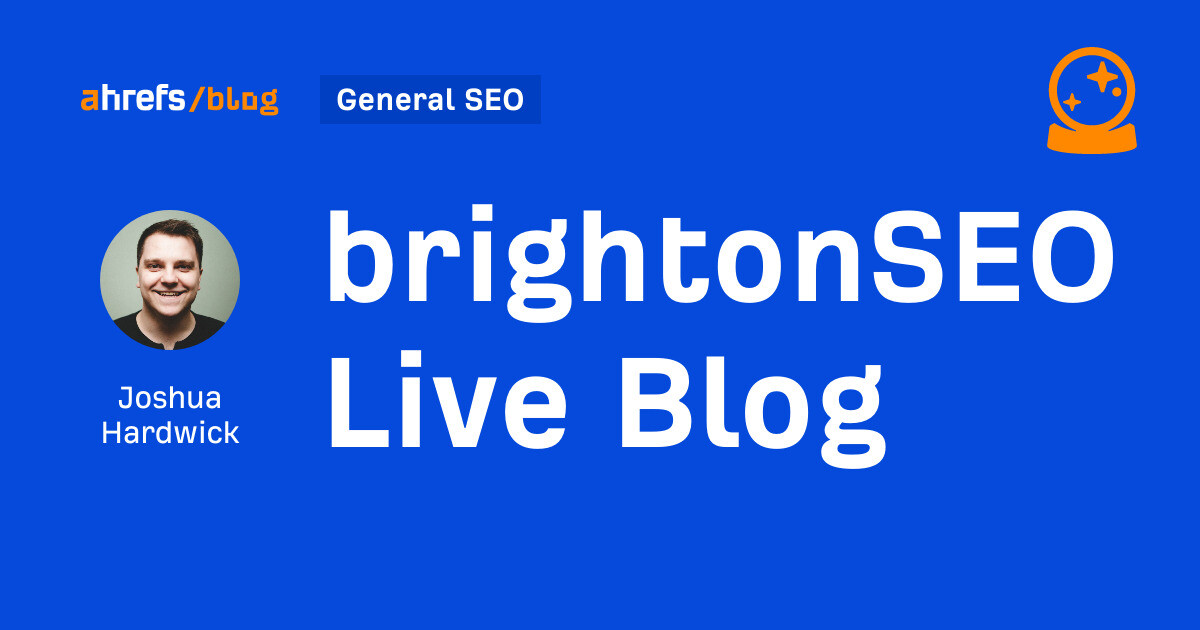
Hello everyone. It’s April again, so I’m back in Brighton for another two days of Being the introvert I am, my idea of fun isn’t hanging around our booth all day explaining we’ve run out of t-shirts (seriously, you need to be fast if you want swag!). So I decided to do something useful and live-blog the event instead.
Follow below for talk takeaways and (very) mildly humorous commentary. sun, sea, and SEO!
SEO
Google Further Postpones Third-Party Cookie Deprecation In Chrome

Google has again delayed its plan to phase out third-party cookies in the Chrome web browser. The latest postponement comes after ongoing challenges in reconciling feedback from industry stakeholders and regulators.
The announcement was made in Google and the UK’s Competition and Markets Authority (CMA) joint quarterly report on the Privacy Sandbox initiative, scheduled for release on April 26.
Chrome’s Third-Party Cookie Phaseout Pushed To 2025
Google states it “will not complete third-party cookie deprecation during the second half of Q4” this year as planned.
Instead, the tech giant aims to begin deprecating third-party cookies in Chrome “starting early next year,” assuming an agreement can be reached with the CMA and the UK’s Information Commissioner’s Office (ICO).
The statement reads:
“We recognize that there are ongoing challenges related to reconciling divergent feedback from the industry, regulators and developers, and will continue to engage closely with the entire ecosystem. It’s also critical that the CMA has sufficient time to review all evidence, including results from industry tests, which the CMA has asked market participants to provide by the end of June.”
Continued Engagement With Regulators
Google reiterated its commitment to “engaging closely with the CMA and ICO” throughout the process and hopes to conclude discussions this year.
This marks the third delay to Google’s plan to deprecate third-party cookies, initially aiming for a Q3 2023 phaseout before pushing it back to late 2024.
The postponements reflect the challenges in transitioning away from cross-site user tracking while balancing privacy and advertiser interests.
Transition Period & Impact
In January, Chrome began restricting third-party cookie access for 1% of users globally. This percentage was expected to gradually increase until 100% of users were covered by Q3 2024.
However, the latest delay gives websites and services more time to migrate away from third-party cookie dependencies through Google’s limited “deprecation trials” program.
The trials offer temporary cookie access extensions until December 27, 2024, for non-advertising use cases that can demonstrate direct user impact and functional breakage.
While easing the transition, the trials have strict eligibility rules. Advertising-related services are ineligible, and origins matching known ad-related domains are rejected.
Google states the program aims to address functional issues rather than relieve general data collection inconveniences.
Publisher & Advertiser Implications
The repeated delays highlight the potential disruption for digital publishers and advertisers relying on third-party cookie tracking.
Industry groups have raised concerns that restricting cross-site tracking could push websites toward more opaque privacy-invasive practices.
However, privacy advocates view the phaseout as crucial in preventing covert user profiling across the web.
With the latest postponement, all parties have more time to prepare for the eventual loss of third-party cookies and adopt Google’s proposed Privacy Sandbox APIs as replacements.
Featured Image: Novikov Aleksey/Shutterstock
SEO
How To Write ChatGPT Prompts To Get The Best Results

ChatGPT is a game changer in the field of SEO. This powerful language model can generate human-like content, making it an invaluable tool for SEO professionals.
However, the prompts you provide largely determine the quality of the output.
To unlock the full potential of ChatGPT and create content that resonates with your audience and search engines, writing effective prompts is crucial.
In this comprehensive guide, we’ll explore the art of writing prompts for ChatGPT, covering everything from basic techniques to advanced strategies for layering prompts and generating high-quality, SEO-friendly content.
Writing Prompts For ChatGPT
What Is A ChatGPT Prompt?
A ChatGPT prompt is an instruction or discussion topic a user provides for the ChatGPT AI model to respond to.
The prompt can be a question, statement, or any other stimulus to spark creativity, reflection, or engagement.
Users can use the prompt to generate ideas, share their thoughts, or start a conversation.
ChatGPT prompts are designed to be open-ended and can be customized based on the user’s preferences and interests.
How To Write Prompts For ChatGPT
Start by giving ChatGPT a writing prompt, such as, “Write a short story about a person who discovers they have a superpower.”
ChatGPT will then generate a response based on your prompt. Depending on the prompt’s complexity and the level of detail you requested, the answer may be a few sentences or several paragraphs long.
Use the ChatGPT-generated response as a starting point for your writing. You can take the ideas and concepts presented in the answer and expand upon them, adding your own unique spin to the story.
If you want to generate additional ideas, try asking ChatGPT follow-up questions related to your original prompt.
For example, you could ask, “What challenges might the person face in exploring their newfound superpower?” Or, “How might the person’s relationships with others be affected by their superpower?”
Remember that ChatGPT’s answers are generated by artificial intelligence and may not always be perfect or exactly what you want.
However, they can still be a great source of inspiration and help you start writing.
Must-Have GPTs Assistant
I recommend installing the WebBrowser Assistant created by the OpenAI Team. This tool allows you to add relevant Bing results to your ChatGPT prompts.
This assistant adds the first web results to your ChatGPT prompts for more accurate and up-to-date conversations.
It is very easy to install in only two clicks. (Click on Start Chat.)
For example, if I ask, “Who is Vincent Terrasi?,” ChatGPT has no answer.
With WebBrower Assistant, the assistant creates a new prompt with the first Bing results, and now ChatGPT knows who Vincent Terrasi is.
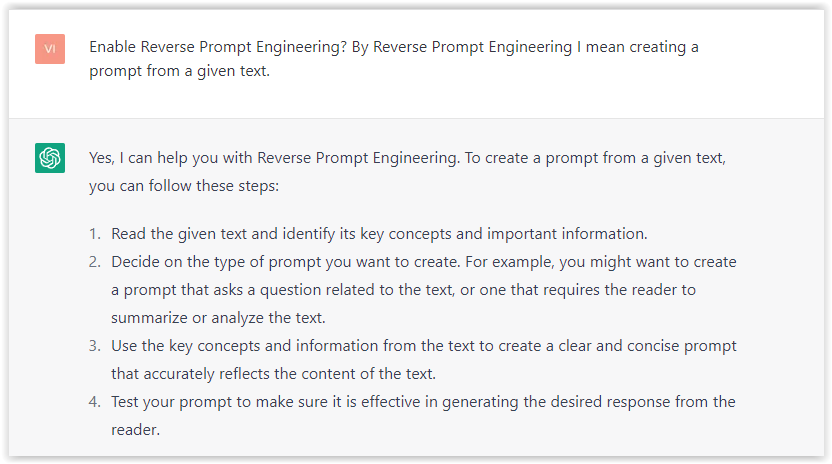 Screenshot from ChatGPT, March 2023
Screenshot from ChatGPT, March 2023You can test other GPT assistants available in the GPTs search engine if you want to use Google results.
Master Reverse Prompt Engineering
ChatGPT can be an excellent tool for reverse engineering prompts because it generates natural and engaging responses to any given input.
By analyzing the prompts generated by ChatGPT, it is possible to gain insight into the model’s underlying thought processes and decision-making strategies.
One key benefit of using ChatGPT to reverse engineer prompts is that the model is highly transparent in its decision-making.
This means that the reasoning and logic behind each response can be traced, making it easier to understand how the model arrives at its conclusions.
Once you’ve done this a few times for different types of content, you’ll gain insight into crafting more effective prompts.
Prepare Your ChatGPT For Generating Prompts
First, activate the reverse prompt engineering.
- Type the following prompt: “Enable Reverse Prompt Engineering? By Reverse Prompt Engineering I mean creating a prompt from a given text.”
 Screenshot from ChatGPT, March 2023
Screenshot from ChatGPT, March 2023ChatGPT is now ready to generate your prompt. You can test the product description in a new chatbot session and evaluate the generated prompt.
- Type: “Create a very technical reverse prompt engineering template for a product description about iPhone 11.”
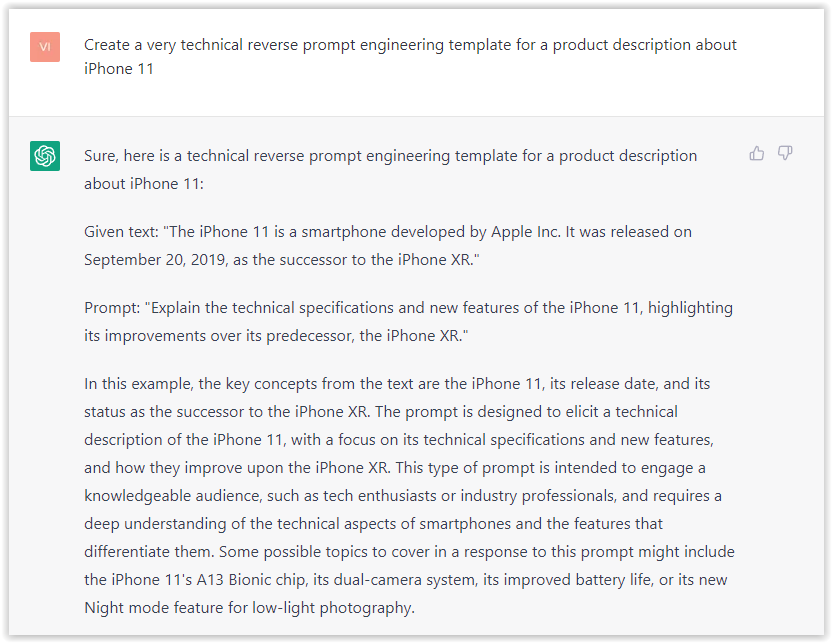 Screenshot from ChatGPT, March 2023
Screenshot from ChatGPT, March 2023The result is amazing. You can test with a full text that you want to reproduce. Here is an example of a prompt for selling a Kindle on Amazon.
- Type: “Reverse Prompt engineer the following {product), capture the writing style and the length of the text :
product =”
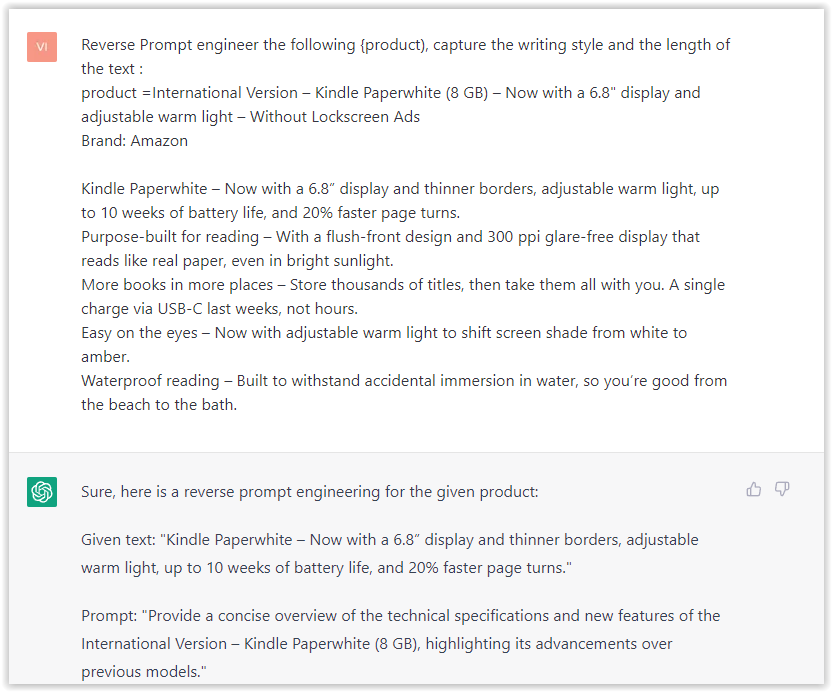 Screenshot from ChatGPT, March 2023
Screenshot from ChatGPT, March 2023I tested it on an SEJ blog post. Enjoy the analysis – it is excellent.
- Type: “Reverse Prompt engineer the following {text}, capture the tone and writing style of the {text} to include in the prompt :
text = all text coming from https://www.searchenginejournal.com/google-bard-training-data/478941/”
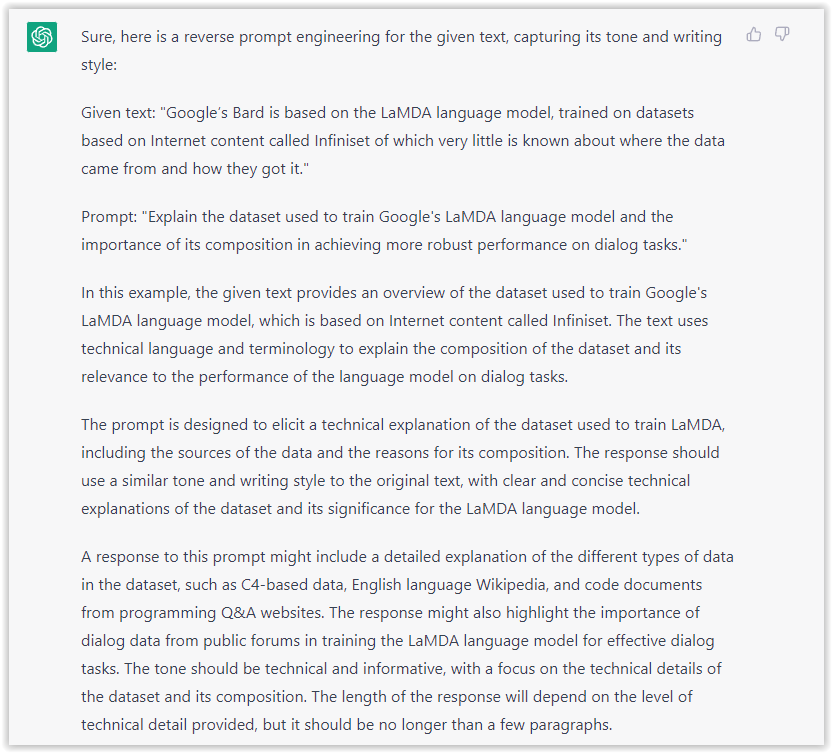 Screenshot from ChatGPT, March 2023
Screenshot from ChatGPT, March 2023But be careful not to use ChatGPT to generate your texts. It is just a personal assistant.
Go Deeper
Prompts and examples for SEO:
- Keyword research and content ideas prompt: “Provide a list of 20 long-tail keyword ideas related to ‘local SEO strategies’ along with brief content topic descriptions for each keyword.”
- Optimizing content for featured snippets prompt: “Write a 40-50 word paragraph optimized for the query ‘what is the featured snippet in Google search’ that could potentially earn the featured snippet.”
- Creating meta descriptions prompt: “Draft a compelling meta description for the following blog post title: ’10 Technical SEO Factors You Can’t Ignore in 2024′.”
Important Considerations:
- Always Fact-Check: While ChatGPT can be a helpful tool, it’s crucial to remember that it may generate inaccurate or fabricated information. Always verify any facts, statistics, or quotes generated by ChatGPT before incorporating them into your content.
- Maintain Control and Creativity: Use ChatGPT as a tool to assist your writing, not replace it. Don’t rely on it to do your thinking or create content from scratch. Your unique perspective and creativity are essential for producing high-quality, engaging content.
- Iteration is Key: Refine and revise the outputs generated by ChatGPT to ensure they align with your voice, style, and intended message.
Additional Prompts for Rewording and SEO:
– Rewrite this sentence to be more concise and impactful.
– Suggest alternative phrasing for this section to improve clarity.
– Identify opportunities to incorporate relevant internal and external links.
– Analyze the keyword density and suggest improvements for better SEO.
Remember, while ChatGPT can be a valuable tool, it’s essential to use it responsibly and maintain control over your content creation process.
Experiment And Refine Your Prompting Techniques
Writing effective prompts for ChatGPT is an essential skill for any SEO professional who wants to harness the power of AI-generated content.
Hopefully, the insights and examples shared in this article can inspire you and help guide you to crafting stronger prompts that yield high-quality content.
Remember to experiment with layering prompts, iterating on the output, and continually refining your prompting techniques.
This will help you stay ahead of the curve in the ever-changing world of SEO.
More resources:
Featured Image: Tapati Rinchumrus/Shutterstock
-

 PPC6 days ago
PPC6 days ago19 Best SEO Tools in 2024 (For Every Use Case)
-
SEARCHENGINES5 days ago
Daily Search Forum Recap: April 19, 2024
-
SEARCHENGINES6 days ago
Daily Search Forum Recap: April 18, 2024
-

 WORDPRESS6 days ago
WORDPRESS6 days agoHow to Make $5000 of Passive Income Every Month in WordPress
-

 SEO7 days ago
SEO7 days ago2024 WordPress Vulnerability Report Shows Errors Sites Keep Making
-

 WORDPRESS7 days ago
WORDPRESS7 days ago10 Amazing WordPress Design Resouces – WordPress.com News
-

 SEO6 days ago
SEO6 days ago25 WordPress Alternatives Best For SEO
-

 WORDPRESS5 days ago
WORDPRESS5 days ago7 Best WooCommerce Points and Rewards Plugins (Free & Paid)
















You must be logged in to post a comment Login